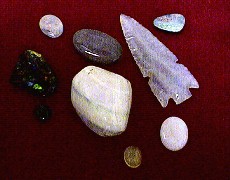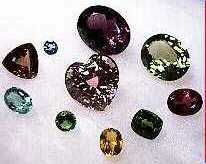 Opal has been called the "Queen of gems." Opal is
silicon dioxide (quartz), and closely related to agates, but with a "hydrated"
structure containing water . A large part of opal's "bad luck" reputation is due
to its tendency to crack and/or "craze" spontaneously as the stone dries with
age.
Opal has been called the "Queen of gems." Opal is
silicon dioxide (quartz), and closely related to agates, but with a "hydrated"
structure containing water . A large part of opal's "bad luck" reputation is due
to its tendency to crack and/or "craze" spontaneously as the stone dries with
age. Tourmaline presents the most vastly varied and spectacular colors of
all known gemstones. the name is derived from the ancient Sinhalese word
"turmali," loosely translated as "mixed gemstones." Apparently early Ceylonese
gem dealers were unable to identify some gemstones, not a few of which were
tourmalines. Tourmaline is actually a general group name that is applied to
several minerals with similar chemical compositions and the same crystal
structure. Tourmaline possesses no cleavage and doesn't tend to chip easily. It
generally does tend, however, to contain small flaws (cracks and inclusions),
especially in pink and red material, to the point that flawless gemstones are
unusual. For that reason, tourmalines, like emeralds, are acceptable with some
flaws in order to obtain the gemstone at reasonable prices for "commercial"
jewelry. This is especially true for the red varieties (known as "rubellite"),
pinks, and for most stones with multiple colors along one crystal axis.
Different colors on different crystal axes are the norm, with
singular-color tourmaline being somewhat of a rarity.
Tourmaline presents the most vastly varied and spectacular colors of
all known gemstones. the name is derived from the ancient Sinhalese word
"turmali," loosely translated as "mixed gemstones." Apparently early Ceylonese
gem dealers were unable to identify some gemstones, not a few of which were
tourmalines. Tourmaline is actually a general group name that is applied to
several minerals with similar chemical compositions and the same crystal
structure. Tourmaline possesses no cleavage and doesn't tend to chip easily. It
generally does tend, however, to contain small flaws (cracks and inclusions),
especially in pink and red material, to the point that flawless gemstones are
unusual. For that reason, tourmalines, like emeralds, are acceptable with some
flaws in order to obtain the gemstone at reasonable prices for "commercial"
jewelry. This is especially true for the red varieties (known as "rubellite"),
pinks, and for most stones with multiple colors along one crystal axis.
Different colors on different crystal axes are the norm, with
singular-color tourmaline being somewhat of a rarity. VALLEY JEWELERS Phone: 925-387-8050
1175-D ARNOLD DRIVE
MARTINEZ, CA 94553